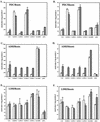Enhanced low oxygen survival in Arabidopsis through increased metabolic flux in the fermentative pathway
- PMID: 12857811
- PMCID: PMC167069
- DOI: 10.1104/pp.103.022244
Enhanced low oxygen survival in Arabidopsis through increased metabolic flux in the fermentative pathway
Abstract
We manipulated the enzyme activity levels of the alcohol fermentation pathway, pyruvate decarboxylase (PDC), and alcohol dehydrogenase (ADH) in Arabidopsis using sense and antisense overexpression of the corresponding genes (PDC1, PDC2, and ADH1). Transgenic plants were analyzed for levels of fermentation and evaluated for changes in hypoxic survival. Overexpression of either Arabidopsis PDC1 or PDC2 resulted in improved plant survival. In contrast, overexpression of Arabidopsis ADH1 had no effect on flooding survival. These results support the role of PDC as the control step in ethanol fermentation. Although ADH1 null mutants had decreased hypoxic survival, attempts to reduce the level of PDC activity enough to see an effect on plant survival met with limited success. The combination of flooding survival data and metabolite analysis allows identification of critical metabolic flux points. This information can be used to design transgenic strategies to improve hypoxic tolerance in plants.
Figures





References
-
- Boyer JS (1982) Plant productivity and environment. Science 218: 443–448 - PubMed
-
- Braun KP, Cody RB, Jones JDR, Peterson CM (1995) A structural assignment for a stable acetaldehyde-lysine adduct. J Biol Chem 270: 11263–11266 - PubMed
-
- Davies DD (1980) Anaerobic metabolism and production of organic acids. In PK Stumpf, EE Conn, eds, The Biochemistry of Plants: A Comprehensive Treatise, Vol 2. Academic Press, New York, pp 581–611
Publication types
MeSH terms
Substances
LinkOut - more resources
Full Text Sources
Other Literature Sources
Molecular Biology Databases
Miscellaneous

